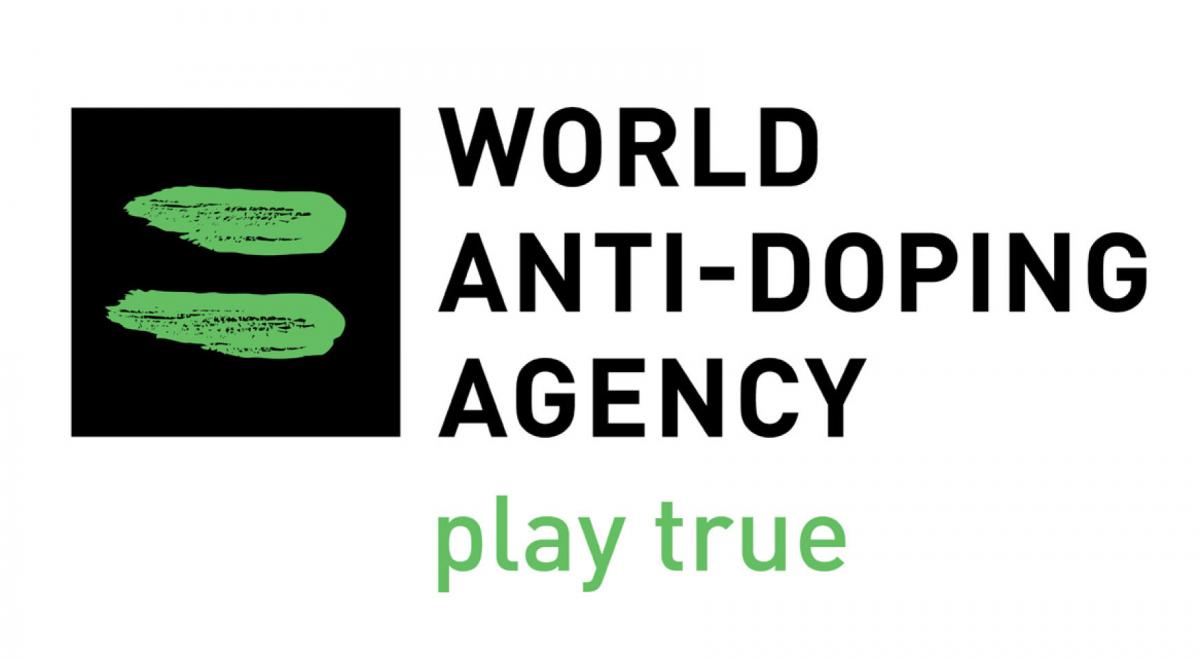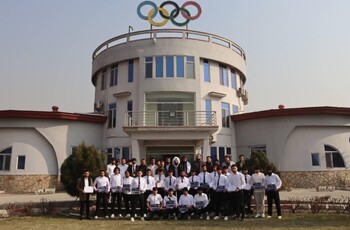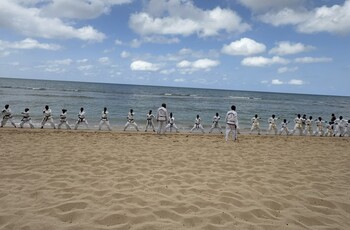International Taekwon‑Do Federation
TESTING, INTELLIGENCE
The aim of testing is to detect and deter doping among athletes to protect clean athletes.
Any athlete under the testing jurisdiction of the ITF may be tested at any time, with no advance notice, in- or out-of-competition, and be required to provide a urine or blood sample.
WHAT ARE TESTING POOLS AND WHY ARE WHEREABOUTS IMPORTANT FOR CLEAN SPORT?
No-advance notice out-of-competition testing is one of the most powerful means of deterrence and detection of doping. To support this type of testing, the ITF has created testing pools as part of its testing program.
Certain athletes in the ITF testing pools, such as those in the Registered Testing Pool (RTP) are required to provide information on their whereabouts in ADAMS, WADA’s online anti-doping administration and management system.
The ITF updates the composition of the testing pools (RTP) regularly/at least yearly.
Athletes in the RTP are chosen based on set criteria.
At-a-Glance: Athlete Whereabouts leaflet
WADA’s webpage on ADAMS
HOW DO ATHLETES KNOW THEY NEED TO PROVIDE WHEREABOUTS?
Athletes who need to provide whereabouts in ADAMS for the ITF are notified by the ITF (or by their national federation) of their inclusion in the ITF’s testing pool as well as what information exactly is required of them, how to use ADAMS, deadlines to submit this information and any consequences if the information required is not submitted.
WHAT DO RTP ATHLETES NEED TO KNOW?
WADA’s webpage on ADAMS
ADAMS login page
ADAMS Athlete User Guide
ADAMS Athlete Biological Passport User Guide
ADAMS Whereabouts Quick Reference Card
ADAMS Security Questions
WHAT SHOULD ATHLETES DO ITF THEY WISH TO RETIRE OR RETURN TO COMPETITION AFTER RETIRING?
All ITF-licensed athletes who decide to retire from competition must inform the ITF through their National Federations sending the ITF Retirement Notification Form to and in copy to .
For RTP athletes, as soon as the retirement is officially confirmed to the ITF, the athlete will be withdrawn from the ITF’s RTP with immediate effect.
If an athlete wishes to resume competing, they will not be able to do so until they have given the ITF written notice of their intent to resume competing and made themselves available for testing for a period of six months.
Please consult Article 5.7 of the ITF Anti-Doping Rules.
Consequences of doping
Athletes take a huge risk when they take prohibited substances or use banned methods, and there are financial, legal, social and especially health consequences to take into consideration.
○ HEALTH CONSEQUENCES
Physical: The effect on an athlete’s health can be severe, depending on the substance, dose and regularity of use, and the damage done to the body cannot be reversed in many cases. Certain side-effects can even be life-threatening.
Mental: Many doping substances are not only harmful to the body, they can also affect and impair the mind, with effects ranging from anxiety and hallucinations to permanent psychosis having been scientifically linked to doping.
○ SOCIAL CONSEQUENCES
A positive test can have a significant effect on an athlete’s entire life, because as well as being dangerous to one’s health, doping can result in a loss of standing, respect and credibility, and often, the media and public will not believe a negative test in the future. A bad image sticks in the consciousness, and the athlete becomes isolated. However, doping offenders cheat not only other people, but themselves, too.
○ FINANCIAL CONSEQUENCES
Particularly at elite level, violating anti-doping rules incurs financial losses, and sponsors have to be refunded and prize monies returned. Bans of several years or even life mean that offenders cannot continue to live in the manner to which they are accustomed, and in the worst-case scenario, they will fall into debt as ongoing costs still have to be paid or high repayments made
○ LEGAL CONSEQUENCES
Doping can have far-reaching legal consequences – offenders face being banned from sporting competitions and organised training. As a rule, bans last for at least several months and if the athlete reoffends, potentially for life.
In Taekwon‑Do Tournament, the whole team can be banned if several players test positive.
Urine test procedure
The procedure for a urine test is laid down and is generally always the same.
First, the doping control officer introduces him or herself and checks the player’s identity. The player can demand to see the officer’s official identification. The officer must then inform the player of the reason and the procedure of the steps to be followed and ensure that the player is aware of his or her rights and responsibilities during the test. The player is informed that
· the sample collection is to be conducted under ITF’s authority
· he or she is required to undergo the sample collection
· failure to comply may involve consequences
· should he or she choose to consume any food or fluids (non-alcoholic drinks) either provided or his/her own, prior to providing a sample, it is entirely at his or her own responsibility
· the sample provided by the player to the ITF doping control officer shall be the first urine passed by the player subsequent to the summons to the doping control
After further formalities have been explained, the officer begins the test: the player is given two sealed and sterilised beakers and a separate box containing two sealed and numbered bottles, one sample marked “A” and the other sample “B”. At this point, both the ITF doping control officer and the player shall check that all seals on the selected equipment are intact.
The player urinates into the beaker under the direct supervision of the doping control officer or his assistant.
The officer or his assistant shall ensure an unobstructed view of the sample leaving the player’s body. The total urine volume in bottles “A” and “B” shall be at least 90ml. Where the volume of urine is insufficient, the officer shall inform the player that a further sample shall be collected.
The samples are then taken to a WADA-approved and -accredited laboratory. The ITF Anti-Doping Unit shall define criteria ensuring that any sample will be stored in a manner that protects its integrity, identity and security prior to transport from the doping control room to the laboratory.
After they have been safely transported, the sealed “A” and “B” bottles are opened and examined by laboratory staff only. The laboratory obtains the results of the “A” sample, stores the “B” sample for any potential examination at a later time and passes on the results to ITF. The player is only informed of a positive result.
Blood test procedure
As a rule, blood samples are taken before urine samples. The doping control officer explains the blood collection procedure to the players so that they know what will happen in advance and that they must comply with the procedure.
Before the sample is collected, the player is asked questions such as whether he or she has any bleeding disorder that may have an effect on clotting time or if he or she has taken medications that may affect the blood-drawing procedure (particularly those that affect clotting), e.g. aspirin, warfarin or non-steroidal anti-inflammatory agents. Every player should be aware of this before any doping control is carried out.
To ensure that the player’s performance is not affected, less than a teaspoonful of blood is taken. The player must sit for at least 20 minutes before the sample is collected, after which the ITF doping control officer checks the player’s skin and finds an appropriate place on which to commence the process. He or she disinfects the skin with a sterile wipe or swab and, if required, apply a tourniquet. Several cannulas of blood may be taken, but the total amount will never exceed a teaspoonful. After the sample has been collected, the player and officer check together that the box has been correctly labelled and sealed. The doping control officer places the coded, sealed box containing the player’s blood sample into the transport cooling bag.
Reasons behind doping
What drives athletes to take prohibited substances and thus unfairly improve their performance?
There are many reasons, and they vary from athlete to athlete and from situation to situation.
○ Pressure to perform
Some athletes feel under considerable pressure to perform at their best, either from outside or from themselves, and resort to doping as they cannot see any other way. Even young athletes at the beginning of their career are susceptible to this pressure.
○ Injury
Injuries are part and parcel of elite sport, and lengthy physical restrictions and problems can lead athletes to take banned substances in an attempt to accelerate the healing process.
○ Ignorance
Many athletes do not know precisely which substances and methods are on WADA’s official prohibited list.
This ignorance can, for example, result in a positive doping test through the wrong diet or food supplements.
○ Performance limits
Some athletes cannot or will not accept their natural limits and deliberately resort to prohibited substances or methods to enhance their performance.
○ Failure
Training hard and preparing thoroughly for competitions and games is sometimes not enough, and many athletes then see the taking of banned substances as the only solution.
Hidden doping traps / Risks of unintentional doping
To avoid falling into the hidden doping trap through naive eating habits or careless everyday behaviour, athletes should be aware at all times that they have to face the consequences of testing positive, regardless of whether or not they are aware of the offence.
○ Food supplements
Food supplements are substances that enhance the overall diet and have a specific dietary or physiological effect. They include vitamins, minerals, trace elements, amino acids and proteins, as well as fibre, plant and herb extracts. There is a vast array of food supplements and many athletes take them, particularly at elite level, to meet their greater need for energy and nutrients.
They are generally taken in the form of tablets, liquids, capsules or powder. However, they are foodstuffs that enhance the daily diet, not drugs or medication, and athletes who must abide by anti-doping rules need to be particularly careful, as using food supplements can result in unknowingly and unintentionally failing doping tests. It is not uncommon for such supplements to become contaminated with doping-relevant substances, whether through the filling process, substances not listed on the packaging or simply deliberate manipulation. In addition, the manufacturing criteria are very different to those of drugs – it is impossible to be completely sure. According to WADA, an increasing number of products contain banned substances such as steroids or their precursors. The consequences can be serious: taking contaminated food supplements can lead to positive urine samples, which constitutes doping in accordance with the principle of strict liability as applied in the anti-doping rules.
Before the athlete takes such a supplement, the latter must have been tested by an independent institution for the presence of a prohibited substance. A declaration by the manufacturer as to the product’s purity should be a minimum requirement for every athlete. Although these steps can reduce the doping risk where food supplements are concerned, athletes should not lose sight of their responsibilities or of the potential consequences.
DEFINITION of food supplement:
In EU law, food supplements are regulated by the 2002/46/EG directive, which includes the permitted minerals and vitamins. In the Nahrungsergänzungsmittelverordnung (Food Supplements Regulations), which are based on the above directive, a food supplement is defined as
“any food the purpose of which is to supplement the normal diet and which is a concentrated source of a vitamin or mineral or other substance with a nutritional or physiological effect, alone or in combination and is sold in dose form, which means in the form of capsules, pastilles, tablets, pills and other similar forms, sachets of powder, ampoules of liquids, drop dispensing bottles, and other similar forms of liquids or powders designed to be taken in measured small unit quantities.“
○ Medication
There are drugs, medications and homeopathic remedies that every athlete can buy without a prescription, e.g. from a chemist’s, and, it would seem, take with a clear conscience. However, this is not the case: even medication that seems at first glance to be harmless may contain substances that violate anti-doping rules. Better safe than sorry: athletes should consult their doctor before taking medication if suffering from a cold, a slight headache, nausea or allergies. That is the only way to be sure of avoiding doping.
○ Cannabinoids
The consumption of cannabis outside sporting competitions is not banned in every country. Moreover, cannabinoids (marijuana, hashish) do not necessarily improve performance, especially in competitive sport, because cannabis has a relaxing effect, thus reducing sporting ambition. Nevertheless, cannabis is prohibited during competition as its calming effect and alteration of the perception serve to lower inhibition to the extent that the athlete is prepared to take greater risks.
○ Everyday food
Consuming normal food and drink can also result in a positive test if they contain banned substances. The most well-known example is the poppy, the seeds of which contain morphine, a substance on WADA’s prohibited list. Depending on the poppy seeds and the amount involved, an increased concentration of morphine can, in extreme cases, ensue and thus lead to a positive doping test.
Asian herbal teas are another example: ephedra is a medicinal plant that is used to counteract colds in traditional Chinese medicine, but it can result in a positive test as this stimulant is also prohibited.



















